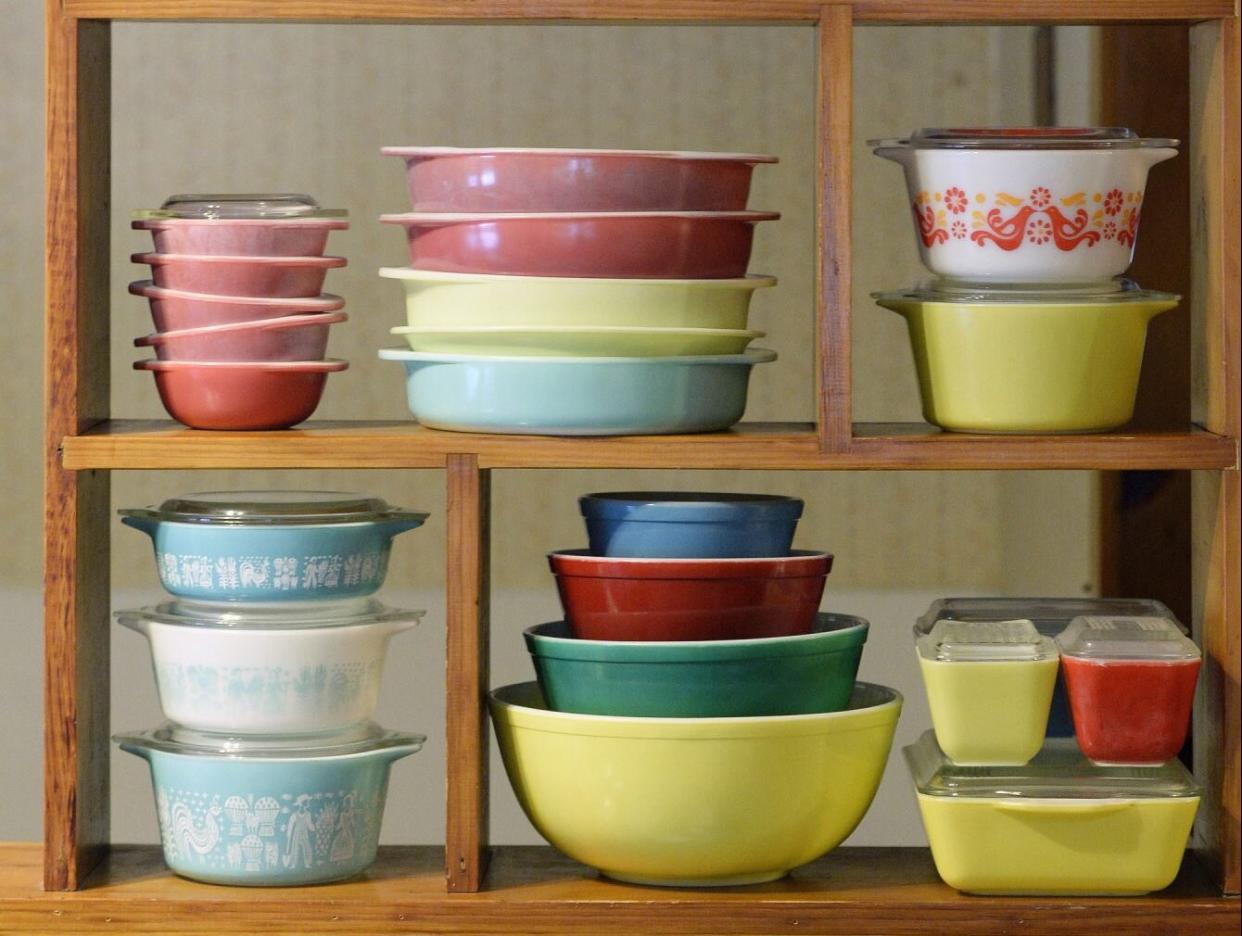A Guide to Collecting Vintage Pyrex—Plus, How Much It's Worth

Shawn Patrick Ouellette / Portland Press Herald / Getty Images
TABLE OF CONTENTS
On This Page
History of Pyrex
Finding Vintage Pyrex
Determining Its Value
Authenticating It
Caring for It
Vintage Pyrex pieces are hardly a rarity. Until recently, old Pyrex was purchased mainly by longtime devotees unable to find replacements for a broken coffee pot or chipped mixing bowl. But in the past few years, old Pyrex has attracted new admirers. While those who grew up with it are familiar with its durability, vintage Pyrex is now catching on with younger generations who appreciate the beauty of these throwback pieces. Although a nostalgic collector might buy a mixing-bowl set because it stirs memories or complements their mid-century modern design aesthetic, Pyrex is functional and almost demands to be used.
The History of Pyrex
Before Pyrex became the beloved brand we know today, it was simply a small line of machine-made glass ovenware. Its rich history dates back to 1915, when it was launched by a New York-based company.
Naming Pyrex
The colorful mixing bowls and food storage containers that filled kitchen cabinets in the 1950s still exude cheerful domesticity. A vast amount of Pyrex was manufactured—and still is—by Corning Glass Works of Corning, N.Y. Before landing on its trademark name, the company considered candidates like Pie-Right and Py-Right. Ultimately, it landed on Pyrex as it blended the sound of the word pie with the "X" frequently used on Corning products.
Testing Pyrex
Women were very involved with the evolution of the brand. According to the Corning Museum of Glass, the company hired several women to join the team in order to test and promote the Pyrex brand. Notable women included in the project were Mildred Maddocks, from the Good Housekeeping Institute, and Sarah Tyson Rorer, an editor for Ladies Home Journal.
Launching Pyrex
The company introduced Pyrex in 1915 as a 12-piece line of machine-made glass ovenware comprised of casserole dishes, pie plates, custard cups, shirred egg dishes, individual baking dishes, and a loaf pan. It was an immediate success—and a notable improvement over the metal utensils of the time. Food cooked more quickly without sticking, food flavors disappeared after washing, and it was easier to see when the food was done.
A torrent of new Pyrex products followed, from pie plates and casserole dishes in various sizes to platters, vegetable dishes, and even salt and pepper shakers. Available at most hardware and department stores, Pyrex often cost less than a dollar apiece at the time. "Pyrex cookware is something that could be found in almost every household until 20 years ago," says Nicolas Martin, flea market expert and founder of Flea Market Insiders.
Where to Find Vintage Pyrex
Since so many Pyrex pieces were made for a short time, part of the fun is finding unexpected items—canning jars, baby bottles, and even percolators with wooden handles. Although antiques dealers are beginning to carry it, Pyrex usually turns up in more humble settings, like yard sales, flea markets, and thrift shops.
Related: These Are the 9 Antique Trends New—and Experienced—Collectors Need to Know About in 2023
How to Determine the Value of Vintage Pyrex
The price often depends on the object's desirability and condition. While a set of old custard cups may fail to sell for 50 cents, a four-color, four-piece mixing bowl set can cost from $45 to $65.
Pattern
Patterned Pyrex—such as the 1956 Pink Daisy or the 1983 Colonial Mist—tend to be valuable as a collector's item. Other popular patterns include the 1957 Butterprint, which features an Amish couple and their crops, and has been valued at a few hundred dollars. You will want to identify which pattern you have and its year to determine how much it's worth in the marketplace. "Depending on condition, expect anywhere from $100 per piece to $500 for a collection or a unique Hot 'N' Cold chip and dip set," says Martin.
Condition
Condition can determine whether an object is desirable or merely junk. Even without its stem and basket, a percolator in good shape makes an attractive coffeepot and can sell for $15 to $20, or for about $50 for a complete model. But colored Pyrex must look shiny and new. "A lot of it was ruined by dishwashers," says David Ross, a vintage-kitchenware dealer from Melrose, Massachusetts.
Practicality
Practicality can also affect an item's allure. Cinderella nesting bowls—a late 1950s design flanked by a pair of lips for gripping and pouring—are less popular with collectors than the lipless bowls. This is mainly because the lipped bowls take up a lot of room in kitchens.
How to Authenticate Vintage Pyrex
Pyrex is easy to authenticate because pieces were marked with a logo. In their book, Rogove and Steinhauer show 23 back stamps used between 1915 and 1965 to identify Pyrex. Some of the stamps can also be used to authenticate Flameware—the aluminosilicate glass Corning manufactured between 1936 and 1979 for percolators, double boilers, and other items used on the stove top.
Authenticating other items can be more of a challenge, but there are a few obvious indicators to look for. Clear glass manufactured until 1934 has a yellowish tinge due to the arsenic added to help shape the glass. Flameware made from 1936 until shortly after the war was tinted blue to distinguish it from Pyrex. And mixing bowls from the '60s are thinner than those made in the '40s.
How to Care for Vintage Pyrex
In many ways, Pyrex is as practical today as it was 40 years ago. The retro glass pieces can go in the oven, the freezer, and the refrigerator. With that being said, some colored Pyrex has metallics in the paint, it probably shouldn't go in the microwave. Pyrex should also be washed by hand, as dishwasher detergent can destroy the color.

